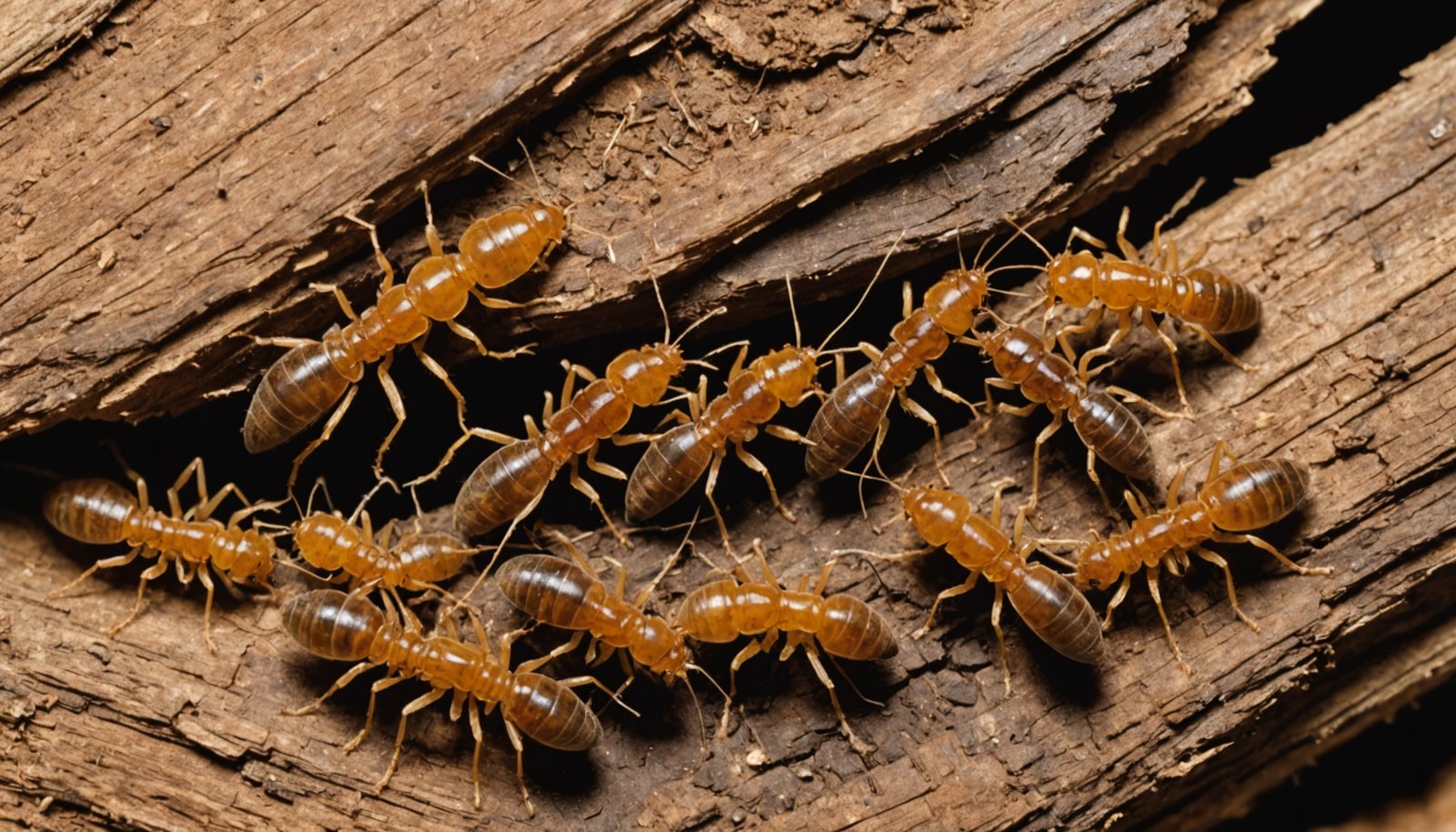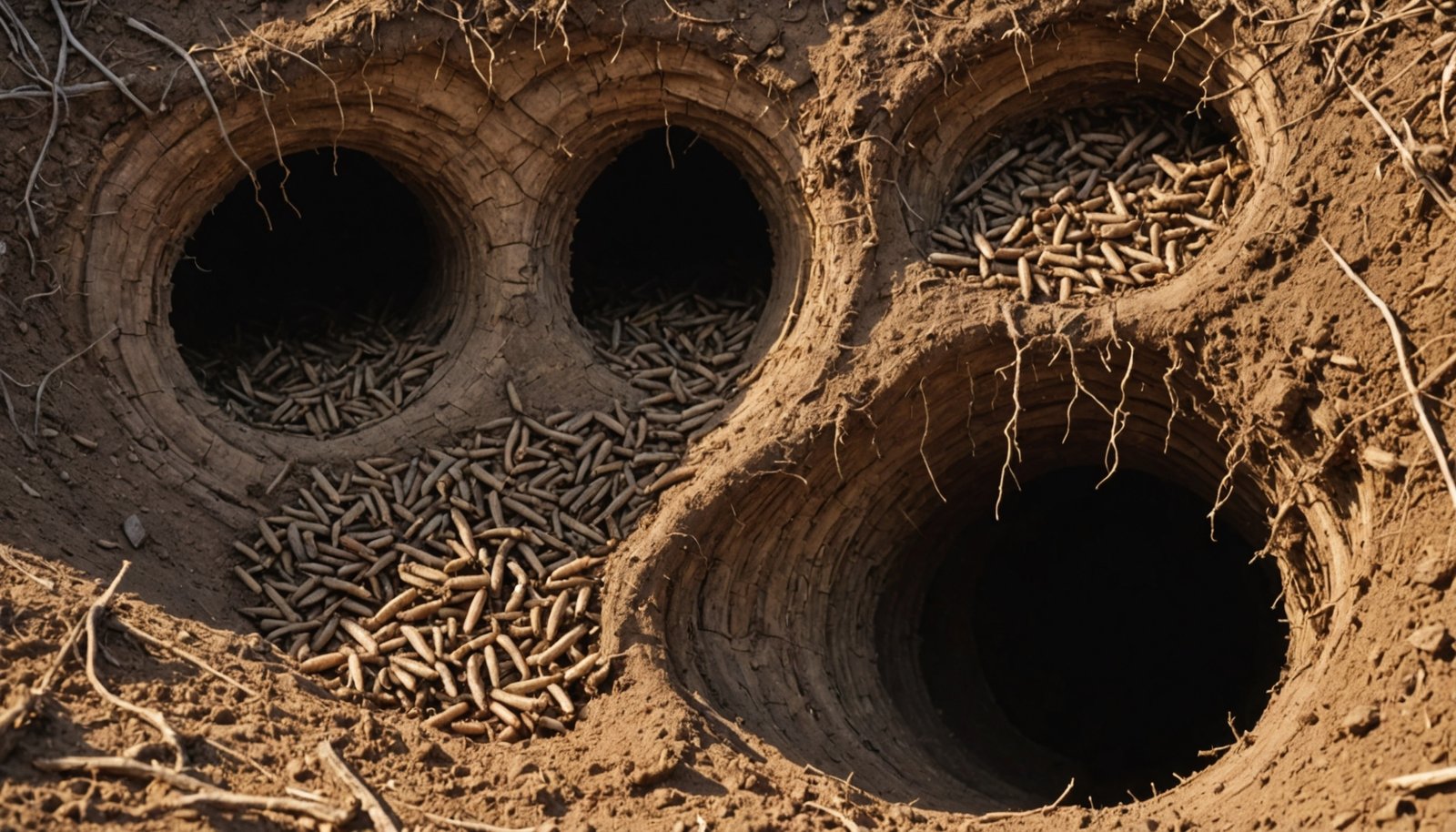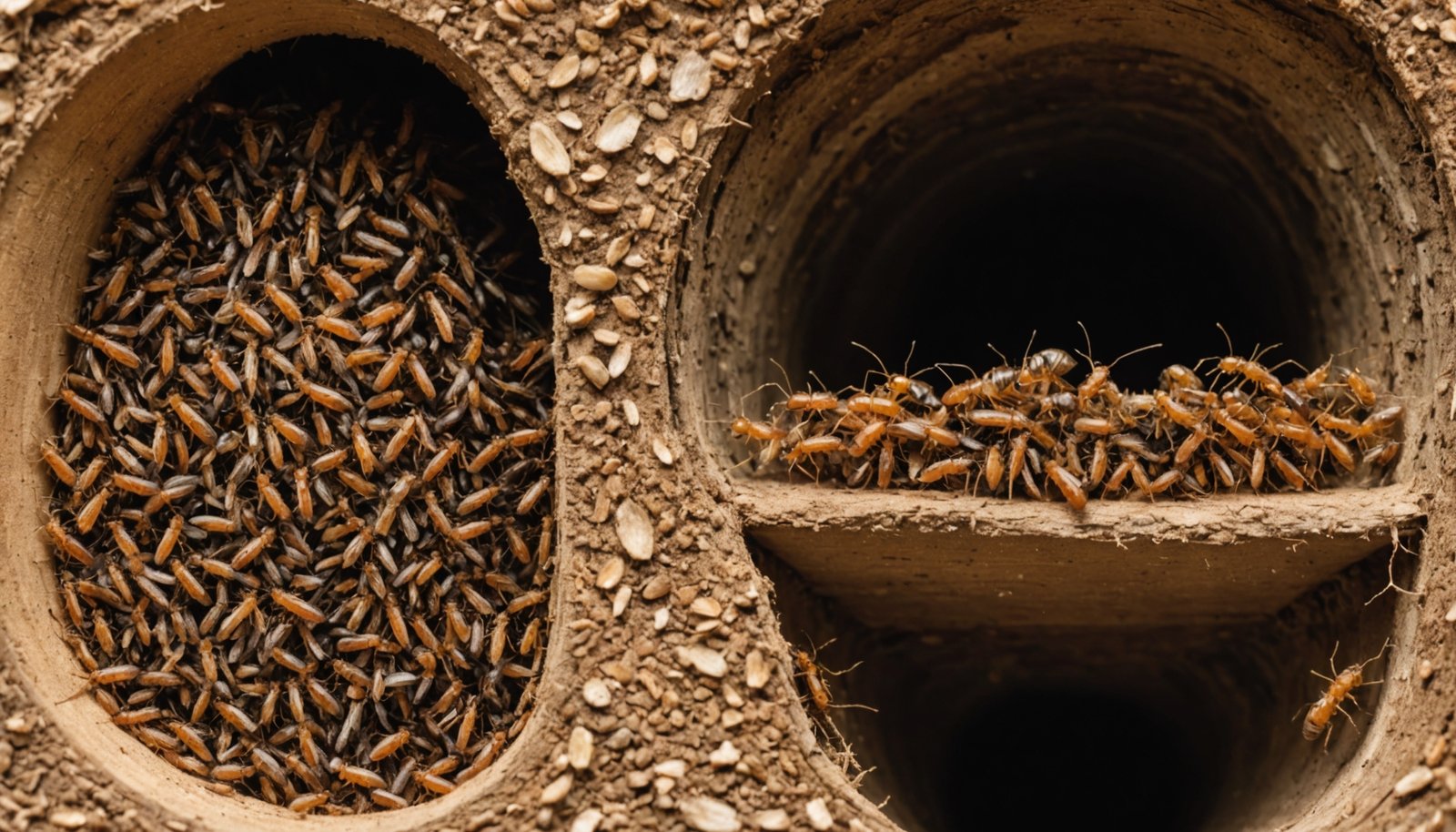Subterranean Vs Drywood Termites: How to Tell the Difference
You can identify subterranean and drywood termites by their distinct characteristics. Drywood termites are larger (⅜-1 inch) with harder bodies and leave behind sawdust-like frass, while subterranean termites are smaller (⅛-⅜ inch) with softer bodies and create distinctive mud tubes. Drywood termites nest directly in wood and don’t need soil contact, but subterranean termites require moisture and ground connection. Understanding these key differences will help you tackle your termite problem effectively.
Key Takeaways
- Drywood termites (⅜-1 inch) are noticeably larger than subterranean termites (⅛-⅜ inch) and have harder exoskeletons.
- Subterranean termites build distinctive mud tubes for travel, while drywood termites leave behind sawdust-like frass near infested areas.
- Drywood termites create dry, clean-cut galleries in wood, whereas subterranean termite damage appears damp and is concentrated near ground level.
- Subterranean termites require soil contact and high moisture, while drywood termites live entirely within wooden structures without ground contact.
- Drywood termites drop their wings after swarming, but subterranean termites keep their wings for nuptial flights.
Physical Characteristics and Size Differences

Several key physical differences distinguish drywood termites from their subterranean cousins.
You’ll notice that drywood termites are larger, measuring ⅜ to 1 inch long, while subterranean termites are significantly smaller at ⅛ to ⅜ inches.
When examining these termite species, you’ll find drywood termites have a harder exoskeleton compared to the softer bodies of subterranean termites.
Color differences can help you identify them too.
Drywood termites range from pale to dark brown, while subterranean termites vary from cream to black.
Both species possess translucent wings of equal size, but their wing shedding behaviors differ.
Drywood termites drop their wings shortly after swarming, while subterranean termites retain theirs for nuptial flights.
You can also identify soldier termites of the subterranean variety by their distinctive large, yellowish-brown heads.
Habitat and Nesting Behaviors

Beyond their physical differences, these termite species maintain distinct living arrangements and colony structures.
Subterranean termites build extensive underground colonies that can house up to two million members, requiring constant soil contact and high moisture levels for survival. You’ll spot their distinctive mud tubes, which they construct from soil and saliva to travel between their nests and food sources.
Termites’ survival depends on massive underground cities, where millions thrive by building mud highways between their nests and food.
Drywood termites, however, don’t need soil contact or build mud tubes. They create smaller colonies directly within wooden structures, particularly in warmer coastal regions.
These termites extract moisture from the wood they consume, allowing them to thrive in drier conditions. While subterranean termite infestations spread rapidly due to their large colonies, drywood termite infestations progress more slowly but can occur in multiple wooden structures throughout your home.
Colony Structure and Social Organization

The social dynamics between subterranean and drywood termites reveal striking differences in their colony structures.
You’ll find subterranean termites living in massive colonies of up to two million members, with a complex caste system that includes specialized workers, soldiers, and reproductive termites. Their intricate social organization allows them to expand rapidly and cause extensive structural damage.
In contrast, drywood termites maintain smaller, more localized colonies of just a few hundred to thousand members. Their simplified social structure reflects their limited size and resource needs.
While subterranean colonies must maintain ground contact for moisture and nesting, drywood termites can establish multiple independent infestations throughout a structure. These distinct growth rates and infestation patterns directly impact how each species develops and spreads within buildings.
Identifying Signs of Infestation
You’ll notice distinctly different calling cards between drywood and subterranean termites, with drywoods leaving behind sawdust-like frass while subterranean species create dark brown mud tubes.
When inspecting for damage patterns, you can identify drywood termite activity through hollow-sounding wood and clean-cut galleries, whereas subterranean damage often appears damp and is accompanied by clicking sounds.
While drywood termites typically infest isolated wood pieces throughout your structure, you’ll find subterranean termites concentrated near ground level, particularly around your home’s foundation where they construct their characteristic mud tubes.
Frass Vs Mud Tubes
Identifying whether you’re dealing with drywood or subterranean termites starts with recognizing their distinctive calling cards. If you notice small, granular pellets resembling sawdust beneath wooden structures, you’ve found frass – a telltale sign of drywood termites. These pellets are pushed out through tiny holes as the termites hollow out the wood.
In contrast, subterranean termites create mud tubes, which are protective tunnels made from soil, wood, saliva, and feces. You’ll typically spot these tubes along foundation walls, floor joints, or any structure connecting to the ground.
While drywood termite damage can remain hidden for years, subterranean termites’ larger colony sizes mean they can cause extensive structural damage much faster. That’s why it’s vital to identify these signs early and take appropriate action.
Damage Pattern Recognition
When inspecting for termite activity, recognizing distinct damage patterns can help you pinpoint which species has invaded your home.
You’ll notice drywood termites create galleries across the wood grain, leaving behind characteristic fecal pellets near tiny holes. In contrast, subterranean termites follow the grain and fill their tunnels with mud or soil.
Here’s what you’ll need to look for:
- Drywood termites: Hollow-sounding wood, granular frass piles resembling sawdust, and discarded wings after swarming
- Subterranean termites: Mud tubes along foundations, dark areas in wood, and soil-filled feeding galleries
- Both species: Bubbling or peeling paint, though only subterranean termites create protective mud tubes
Early detection is essential for effective treatment and control, as both types can cause significant structural damage if left unchecked.
Infestation Location Differences
Locating termite infestations requires understanding key differences between subterranean and drywood species.
You’ll find subterranean termites near moisture sources and soil contact points, where they construct distinctive mud tubes along foundations and walls. They’re commonly found around plumbing areas and damp wooden structures touching the ground.
In contrast, drywood termites don’t need moisture to survive and typically infest dry wooden structures above ground.
You’ll spot their presence in attics, wooden furniture, and upper floors through small holes and accumulation of frass below infected areas.
While signs of drywood termites include granular droppings and hollow-sounding wood, signs of subterranean infestations include bubbling paint and damage along wood grain.
For effective termite control, it’s essential to identify these infestation location differences early.
Geographic Distribution and Climate Preferences
Two distinct climate preferences set subterranean and drywood termites apart in their geographic distribution across the United States.
You’ll find subterranean termites in nearly every state except Alaska, as they thrive in environments with consistent moisture sources. In contrast, drywood termites prefer warmer coastal regions in the southern states.
- Subterranean termites establish large colonies in areas with high humidity and soil moisture, often targeting homes near plumbing fixtures.
- Drywood termites don’t need soil contact and can survive in drier climates by extracting moisture from the wood they infest.
Both species can occupy the same geographic areas, but their distinct habitat preferences influence how infestations develop and determine appropriate treatment methods.
These distribution patterns directly impact how you’ll need to approach prevention and control measures for each species.
Treatment Methods and Control Strategies
You’ll find distinct treatment approaches for subterranean and drywood termites, with options ranging from chemical soil barriers and bait systems to natural solutions like moisture control and wood treatments.
For subterranean termites, you must focus on underground colony elimination through specialized bait systems and soil treatments.
In contrast, drywood termite control often requires either localized wood treatment or whole-structure fumigation.
Regular inspections and preventive maintenance, including moisture management and proper wood-to-ground clearance, will help protect your home from both types of termite infestations.
Chemical Vs Natural Solutions
When choosing between chemical and natural solutions for termite control, you’ll need to evaluate the specific type of termite infestation you’re dealing with.
For subterranean termites, you can opt for chemical treatments like soil barriers or natural solutions such as beneficial nematodes.
Drywood termites typically respond well to localized wood treatments or borate-based products.
- Integrated Pest Management (IPM) combines both approaches, offering a thorough strategy that’s both effective and environmentally conscious.
- Regular moisture control and inspections are essential regardless of your chosen treatment method.
- Working with pest control professionals will help determine the most suitable solution based on your specific situation and termite species.
Remember that successful treatment often requires a tailored approach, considering factors like infestation severity, termite type, and environmental conditions.
Targeted Treatment Approaches
Successfully treating termite infestations requires distinctly different approaches for subterranean and drywood species.
For subterranean termites, you’ll need barrier treatments in the soil and specialized bait systems, along with moisture control to prevent future problems. These pests demand extensive termite inspections for mud tubes and all-encompassing pest control strategies targeting their underground colonies.
Drywood termites, however, call for localized treatments or tent fumigation of wooden structures. You’ll need to focus on identifying frass and hidden structural damage during inspections.
For effective eradication, treatment methods must penetrate the wood where these termites live. To guarantee long-term success, you’ll want regular follow-up inspections and preventive measures tailored to each species, as using the wrong approach can lead to persistent infestations.
Prevention and Maintenance Methods
Regular inspection and maintenance serve as the cornerstone of effective termite prevention for both species, though specific approaches differ based on the type of infestation.
When comparing drywood termites vs subterranean termites, you’ll need to adjust your prevention methods accordingly. Early inspections help identify signs of trouble before infestations become severe.
- For subterranean termites, focus on reducing moisture around your foundation and implement barrier treatments to protect the soil surrounding your home.
- With drywood termites, make certain your wood surfaces are sealed and consider localized treatments for isolated problems.
- Professional pest control services can help establish ongoing prevention strategies tailored to your specific situation.
Remember that different species require different approaches – subterranean termites need ground contact to survive, while drywood termites can thrive in dry, elevated locations.
Conclusion
Now that you’ve learned the key differences between subterranean and drywood termites, you’ll be better equipped to identify and address an infestation in your home. Remember to watch for mud tubes, wood damage patterns, and swarmers specific to each species. Don’t wait to take action – contact a pest control professional immediately if you spot signs of either termite type.

